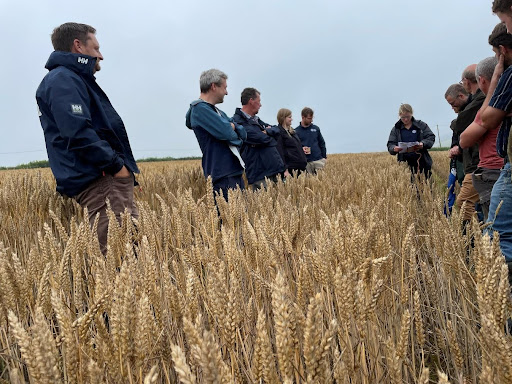

We’re excited to share highlights from our recent Farm Net Zero event at the FNZ demo farm, Pensipple Farm, where host farmer Anthony Ellis opened the gates to show how diversity and efficiency are shaping their carbon journey. Visitors saw first-hand how integrating livestock with a wide range of crops can build resilience, while careful use of data is helping Anthony balance productivity with lower inputs. It was an inspiring day of practical learning and honest discussion about what net zero looks like in practice.
Date of event: Wednesday 16th July 2025
Anthony Ellis farms at Pensipple with his parents and brother, on a 200-acre mixed arable and sheep farm. Pensipple has become the third FNZ Demo Farm, and Anthony Ellis led a farm tour encompassing the cereal trials and sheep integration. The main crops are wheat for livestock feed and oats for biscuit-making, with herbal leys and winter cover crops added to the rotation for fertility-building and sheep grazing. This event was made possible with thanks to the National Lottery Community Fund who fund the Farm Net Zero project.

Septoria is a particularly important disease for SouthWest wheat producers. Anthony explained the trial that he has undertaken this growing season to tackle septoria with reduced chemical inputs. This involved a field split in half between a single wheat variety (Graham) and a mix of nine varieties, the theory being that septoria would spread slower through a mixture of varieties than one single variety. At ninety degrees, the field was split between a conventional fungicide regime and a mineral and biological treatment regime. In the middle of the field, Anthony grazed the wheat with sheep in late winter to remove diseased leaves.
The trial field received 25 tonnes/ha of farmyard manure, lightly cultivated into the soil, and was drilled with a Sumo DTS strip till drill. The field had a post-emergence herbicide and 175kg/ha of nitrogen was applied. In future, Anthony aims to reduce this to 150kg/ha with the last application as liquid fertiliser to improve plant uptake directly from the leaves.
There were two theories behind the mineral and biological treatments:
- to improve the mineral content of the plants so they produce tougher leaves more resilient to infection.
- to plaster the leaves with “good” bacteria that would prevent septoria colonisation.
Results from disease assessments through the growing season suggest that a combination of the cereal variety mixture, conventional fungicide and sheep grazing reduced disease leaves by an estimated 33%. The greatest single effect on reducing diseased leaf area was grazing with sheep. Harvest data will be the final determinant of treatment success, but ear counts hint at the grazed, biologically treated mixture having a higher yield. Detailed results from this trial are available in a factsheet on the FNZ Project Resources webpage.
We were fortunate to be joined by microbiologists from the University of Exeter Penryn; discussions with them may help to inform why the biological treatments were less effective than first hoped. They explained that there is debate over whether applied bacteria can survive once released into the wider environment – the native bacteria are already well-established and may outcompete introductions (particularly in diverse environments with a healthy ecosystem). It is often better to brew up bought-in bacteria before application, as this helps to culture more of them and can kickstart their survival. It may be better still to feed and encourage the farm’s existing bacteria than add new.
The main motivation behind this trial was to reduce production costs, especially with wheat at £160/tonne. Anthony costs the conventional fungicide at £30/ha and plant growth regulator (PGR) at £15/ha, plus the fuel, machinery and labour cost of applying these products. In comparison, the biological and mineral treatments are £25/ha (although this could be reduced as Anthony starts to brew them on-farm) and there are financial benefits to grazing the wheat as it provides a feed value to sheep and reduces the requirement for PGR and potentially fertiliser.
Key takeaways
- The most effective fungicide was grazing with sheep.
- Biological applications may help, but care should be taken to optimise efficacy.
- Plant performance starts from healthy soil.

Recent Comments